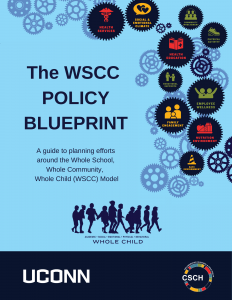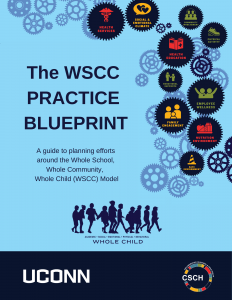The phrase “whole child” has been part of the school lexicon for decades now. Communities have long recognized that schools should be focusing on more than just academics. In 2014, the Center for Disease Control and Prevention and ASCD developed the Whole School, Whole Community, Whole Child, (or WSCC) model, which includes ten domains that can foster student and staff well-being. Using this model, schools have been encouraged to look at the big picture of a child’s development and to recognize the interconnected relationships between a child’s health, well-being, and academic success.
“It’s all related and every aspect affects everything else,” says Sandra Chafouleas, Board of Trustees Distinguished Professor and Neag Endowed Professor in the Department of Educational Psychology in the Neag School of Education. Although the model was developed in 2014, schools have had few resources in figuring out how to integrate the model into their existing systems.
“The WSCC model is exciting but can be overwhelming. Educators, administrators, and boards of education need resources to guide how to put the model into action in coordinating their policies and practices,” says Chafouleas.
New WSCC Resources
Toward that end, the UConn Collaboratory on School and Child Health (CSCH), which Chafouleas co-directs with Human Development and Family Sciences Associate Professor Beth Russell, has spent time developing various tools that help schools implement the WSCC model — whether in school and district policies, practices, or processes.
 Building upon the suite of practice and policy tools it has already developed, CSCH has just released two new resources for schools in Fall 2022: the WSCC Policy and Practice Blueprints, intended to guide planning efforts around the WSCC model. The blueprints walk school staff through various assessments of current practices and policies and offer guides to better align their work with the WSCC model. Activities range from mapping a school’s current resources, evaluating current policies and practices, and action planning around initiatives that could strengthen implementation of the WSCC model. Case studies are woven throughout the blueprints to provide real-world examples.
Building upon the suite of practice and policy tools it has already developed, CSCH has just released two new resources for schools in Fall 2022: the WSCC Policy and Practice Blueprints, intended to guide planning efforts around the WSCC model. The blueprints walk school staff through various assessments of current practices and policies and offer guides to better align their work with the WSCC model. Activities range from mapping a school’s current resources, evaluating current policies and practices, and action planning around initiatives that could strengthen implementation of the WSCC model. Case studies are woven throughout the blueprints to provide real-world examples.
“The goal is not to add more to their plate,” says Chafouleas. “Schools are also encouraged to consider opportunities to end ineffective programs to free up resources for more promising initiatives.”
The two blueprints are meant to complement both the WellSAT WSCC, a school policy evaluation tool developed by CSCH in collaboration with the UConn Rudd Center for Food Policy & Health, and the CSCH WSCC Practice Briefs, which outline evidence-based practices and strategies for each of the WSCC model’s ten domains.
“The blueprints provide a needed framework to make sure that educators, students, and their communities are healthy and better off,” says Althea Marshall Brooks ’91, BS, executive director of the Waterbury Bridge to Success Community Partnership. “The resources offer a comprehensive approach as to the ways that schools can serve communities and communities can serve schools.”
The UConn Collaboratory on School and Child Health
The UConn Collaboratory on School and Child Health (CSCH) was formed in 2016 when Chafouleas and E. Carol Polifroni, retired professor in the UConn School of Nursing and then director of the former UConn Office of Public Engagement, became inspired by the WSCC model.
“The reason for CSCH stemmed from the notion that together, out of our silos, we can do much more to impact the entire system,” says Polifroni. “The WSCC model really spoke to us, because it viewed school and child health through a lens of integration in facilitating whole child success.”
Putting the Whole School, Whole Community, Whole Child Model into Action
CSCH staff hope that the new resources will help schools put that WSCC model into action.
“The WSCC blueprints really simplify and break down the process of implementing the WSCC model into a school’s systems and processes,” says Jessica Koslouski, CSCH postdoctoral scholar and co-creator of the blueprints along with Chafouleas and postdoctoral scholar Emily Iovino. “So often we hear that schools are all in philosophically, but they aren’t sure where to start. These blueprints aim to take the guesswork away and should make it easier for schools.”
Seed funding for the WSCC Blueprint project was provided by the UConn Office of the Vice President for Research, with later external funding provided by the Neag Foundation. CSCH is part of UConn’s Institute for Collaboration on Health, Intervention, and Policy (InCHIP), which provides significant administrative support.




